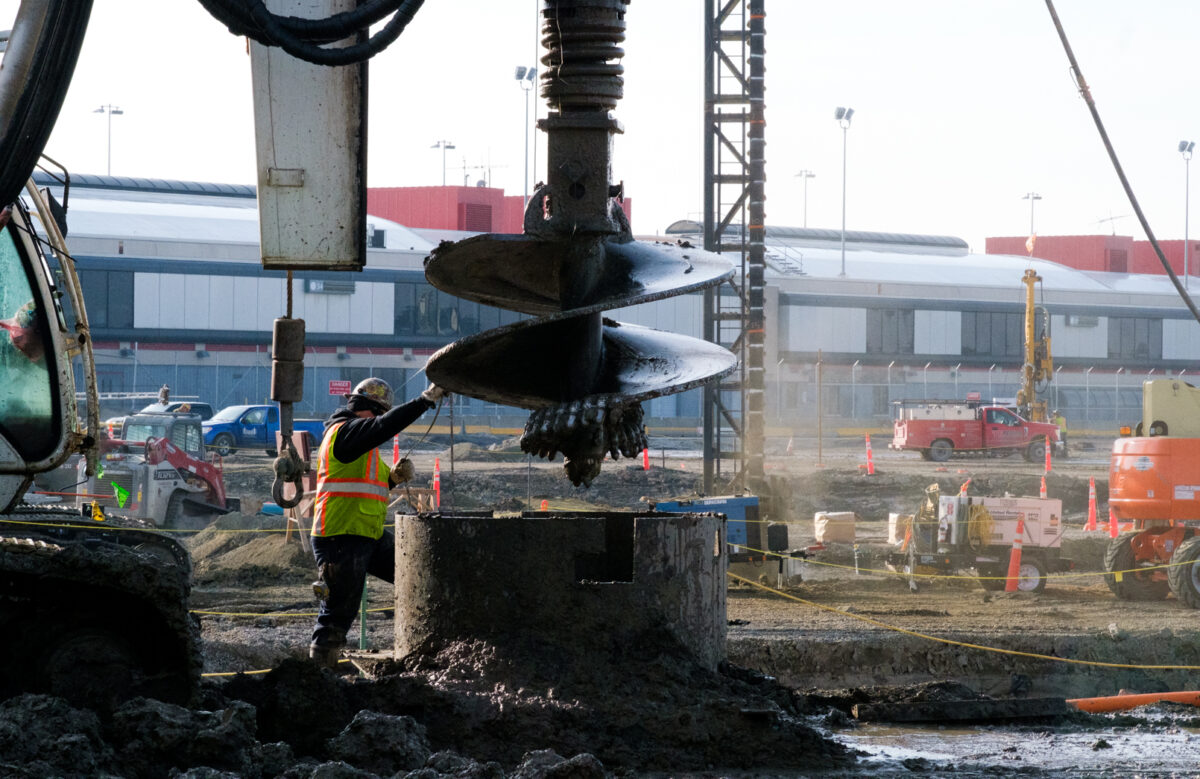
Holiday travelers at Pittsburgh International Airport are likely to notice some interesting sights rising near the Airside Terminal: six large cranes, three drilling rigs, a host of heavy earth-moving equipment and a hive of workers in hard hats and bright yellow clothing.
Right outside the windows of concourses C and D, travelers have a bird’s eye view into the construction site of the airport of the future.
Just before Thanksgiving, contractors from Goettle, which specializes in building deep foundations, began drilling the first of 131 caissons, shafts about five feet in diameter and between 25 and 95 feet deep reinforced with rebar cages and concrete. Those shafts will form the deep foundational supports for a new 700,000-square-foot terminal.
Goettle is one of many subcontractors under prime construction contractor Mascaro, which is responsible for more than $163 million in foundations, slab-on-grade, structural steel and concrete deck work associated with the new terminal.
“The caisson shaft is drilled all the way down to the bedrock so the building isn’t just sitting in dirt, it’s sitting on these caissons,” said Eric Ferguson, general superintendent with PJ Dick/Hunt, the terminal construction manager.
Contractors are simultaneously drilling more than 1,400 smaller-diameter, auger-cast piles throughout the terminal footprint that will also support the building. In total, more than 40 skilled laborers, iron workers, heavy equipment operators, pile drivers and others are on site daily to support the foundation work, which is expected to wrap up in early spring.
“These foundation caissons are the first critical and visible signs of progress in the construction of the new terminal building,” said PIT Chief Development Officer Paul Hoback. “It’s amazing to see history happening daily right outside the windows.”
To mark the official start of major construction on the foundations, contractors also buried a special rebar rod covered in small tags signed by airport employees as part of the ceremonial groundbreaking events.
“I’m so excited to be part of this tremendous step forward for PIT and our region,” wrote Graham Kukucka, the airport’s Commercial Development Manager.
The names and comments on 167 tags are now encased underneath the new terminal, officially part of the new facilities.
Steel arrives at local fabricator
The substantial work on the foundations will be followed by the start of steel erection expected to begin in February.
About 60 percent of some 16,000 total tons of steel needed for the terminal has arrived onsite at Sippel Steel Fab in Ambridge, another Mascaro subcontractor. There, most of it will be cut, drilled, welded and shaped to form the specific parts and pieces needed for the skeleton of the new terminal.
Last month, airport staff got an inside tour of Sippel, a company with a proud local history and deep roots traced to the former site of the American Bridge Company.
That company constructed some of the country’s most famous bridges (Bay Bridge in California and New River Gorge Bridge in West Virginia), buildings (Empire State, Chrysler and U.S. Steel Tower), and WWII tank landing ships on the banks of the Ohio River just a few miles from the airport, near Sippel’s facilities.
Airport staff got to see firsthand some of the primary steel beams and plate girders that will be used to build the new airport. In all, about 1,000 truckloads of steel will be delivered to the construction site via a haul route established on now-closed taxiway Bravo over the next several months.
“I get a tremendous sense of pride standing here, knowing the history of this site and that manufacturing is still very much in our DNA in western Pennsylvania,” Hoback said after the tour at Sippel. “It just makes our project very real.”
To see terminal construction progress photos and timelapse video updates, visit https://www.pittransformed.com/construction-progress/.
Recent Comments